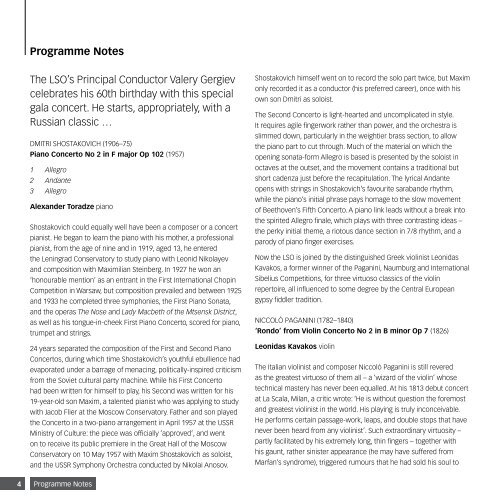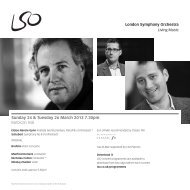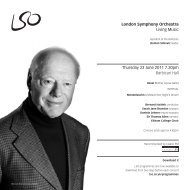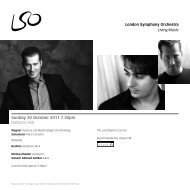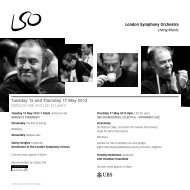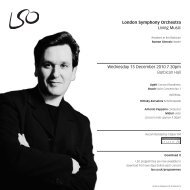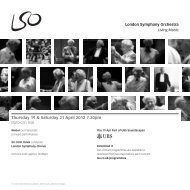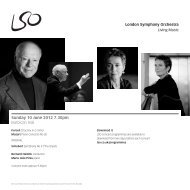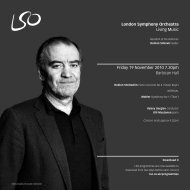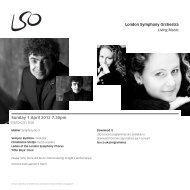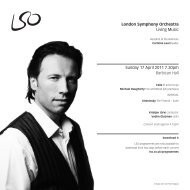Wednesday 22 May: Concert Programme - London Symphony ...
Wednesday 22 May: Concert Programme - London Symphony ...
Wednesday 22 May: Concert Programme - London Symphony ...
Create successful ePaper yourself
Turn your PDF publications into a flip-book with our unique Google optimized e-Paper software.
<strong>Programme</strong> Notes<br />
The LSO’s Principal Conductor Valery Gergiev<br />
celebrates his 60th birthday with this special<br />
gala concert. He starts, appropriately, with a<br />
Russian classic …<br />
DMITRI SHOSTAKOVICH (1906–75)<br />
Piano <strong>Concert</strong>o No 2 in F major Op 102 (1957)<br />
1 Allegro<br />
2 Andante<br />
3 Allegro<br />
Alexander Toradze piano<br />
Shostakovich could equally well have been a composer or a concert<br />
pianist. He began to learn the piano with his mother, a professional<br />
pianist, from the age of nine and in 1919, aged 13, he entered<br />
the Leningrad Conservatory to study piano with Leonid Nikolayev<br />
and composition with Maximilian Steinberg. In 1927 he won an<br />
‘honourable mention’ as an entrant in the First International Chopin<br />
Competition in Warsaw, but composition prevailed and between 1925<br />
and 1933 he completed three symphonies, the First Piano Sonata,<br />
and the operas The Nose and Lady Macbeth of the Mtsensk District,<br />
as well as his tongue-in-cheek First Piano <strong>Concert</strong>o, scored for piano,<br />
trumpet and strings.<br />
24 years separated the composition of the First and Second Piano<br />
<strong>Concert</strong>os, during which time Shostakovich’s youthful ebullience had<br />
evaporated under a barrage of menacing, politically-inspired criticism<br />
from the Soviet cultural party machine. While his First <strong>Concert</strong>o<br />
had been written for himself to play, his Second was written for his<br />
19-year-old son Maxim, a talented pianist who was applying to study<br />
with Jacob Flier at the Moscow Conservatory. Father and son played<br />
the <strong>Concert</strong>o in a two-piano arrangement in April 1957 at the USSR<br />
Ministry of Culture: the piece was officially ‘approved’, and went<br />
on to receive its public premiere in the Great Hall of the Moscow<br />
Conservatory on 10 <strong>May</strong> 1957 with Maxim Shostakovich as soloist,<br />
and the USSR <strong>Symphony</strong> Orchestra conducted by Nikolai Anosov.<br />
Shostakovich himself went on to record the solo part twice, but Maxim<br />
only recorded it as a conductor (his preferred career), once with his<br />
own son Dmitri as soloist.<br />
The Second <strong>Concert</strong>o is light-hearted and uncomplicated in style.<br />
It requires agile fingerwork rather than power, and the orchestra is<br />
slimmed down, particularly in the weightier brass section, to allow<br />
the piano part to cut through. Much of the material on which the<br />
opening sonata-form Allegro is based is presented by the soloist in<br />
octaves at the outset, and the movement contains a traditional but<br />
short cadenza just before the recapitulation. The lyrical Andante<br />
opens with strings in Shostakovich’s favourite sarabande rhythm,<br />
while the piano’s initial phrase pays homage to the slow movement<br />
of Beethoven’s Fifth <strong>Concert</strong>o. A piano link leads without a break into<br />
the spirited Allegro finale, which plays with three contrasting ideas –<br />
the perky initial theme, a riotous dance section in 7/8 rhythm, and a<br />
parody of piano finger exercises.<br />
Now the LSO is joined by the distinguished Greek violinist Leonidas<br />
Kavakos, a former winner of the Paganini, Naumburg and International<br />
Sibelius Competitions, for three virtuoso classics of the violin<br />
repertoire, all influenced to some degree by the Central European<br />
gypsy fiddler tradition.<br />
Niccolò Paganini (1782–1840)<br />
‘Rondo’ from Violin <strong>Concert</strong>o No 2 in B minor Op 7 (1826)<br />
Leonidas Kavakos violin<br />
The Italian violinist and composer Niccolò Paganini is still revered<br />
as the greatest virtuoso of them all – a ‘wizard of the violin’ whose<br />
technical mastery has never been equalled. At his 1813 debut concert<br />
at La Scala, Milan, a critic wrote: ‘He is without question the foremost<br />
and greatest violinist in the world. His playing is truly inconceivable.<br />
He performs certain passage-work, leaps, and double stops that have<br />
never been heard from any violinist’. Such extraordinary virtuosity –<br />
partly facilitated by his extremely long, thin fingers – together with<br />
his gaunt, rather sinister appearance (he may have suffered from<br />
Marfan’s syndrome), triggered rumours that he had sold his soul to<br />
4 <strong>Programme</strong> Notes


